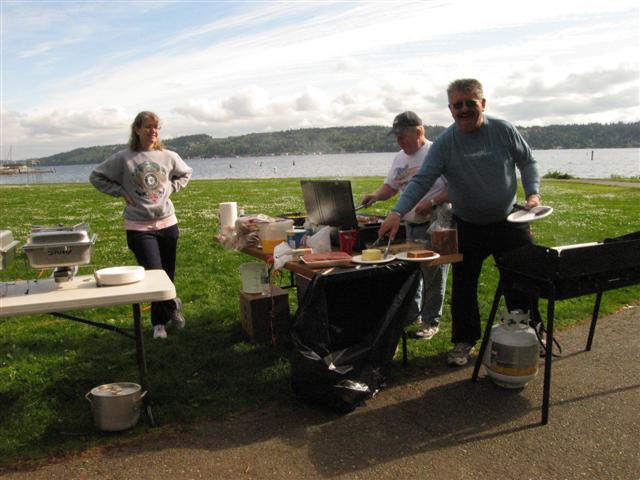.JPG)
What is the climb like and how does one physically prepare?
Truthfully before my first climb I was frightened and excited at the same time. My balance function had been severely destroyed due to brain tumors making stairs a scary experience for me. Further, I had been limited in hiking for a couple years and was not used to the elevation. However, I had built up my endurance by distance walking. My goal was not speed but just to make it to the top.
My fears about the climb dissipated once I discovered that the racers and climbers would be using seperate stairwells. I had terrible visions of being knocked down or trampled by people racing up to the top. I also pictured everyone starting at once like in a large marathon. That does not happen at all. Everyone starts a few seconds apart and enters the stairwell one at a time. Also, the stairways are very narrow where one can grab the handrails on either side for stability or help.
Is it very hard like running a 5 K, 10 K, or completing a marathon?
No, not at all which was another pleasant surprise to me. I had no idea how long it was going to take me to get to the top my first time. I entered the non-timing/non-competitive stairwell but timed myself on my watch. I was amazed how soon it was over compared to other events I have engaged in. I comfortably finished my climb within 15 minutes (and that is without being trained for elevation gain). My husband who has not done events and entered for the first time last year, finished in 17 or 18 minutes. In the brochure it says it could take 20-45 minutes for the climb.
How does one train for the climb?
I have found the best way to prepare is to routinely practice on the stairmaster at the gym (you know, the machine with revolving stairs). If you do not have access to a tall building to practice in, the stairmaster is an EXCELLENT simulator. Although you do not have the advantage of elevation gain, it helps you become accustomed to setting a pace for your climb. Seeing my goal is under 15 minutes, I use the stairmaster for 15-20 minutes. Level 8 will very comfortably get you to 69 floors within 15 minutes. Level 11 will take you 11 1/2 minutes to reach 69 floors and level 12 will take you 10 minutes 40 seconds. Usually, I will set it at the level I feel strong enough to complete the 69 floors, and then drop it down to level 8 or 10 for the remaining 15-20 minutes.
What muscles are used?
You will definitely feel a burn in your quadriceps. Squats and the leg extension machines are a good way to strength train these muscles in addition to the stair master. Of course, those are not the only muscles but the most primary (your glutes and calves will feel it too). I regularly strength train all these muscles anyway using the nautilus equipment at the gym. Lunges are excellent too but very difficult for me without help due to my balance dysfunction. If you are able to do them, I would highly reccommend it as well as step up exercises on the stands of various heights in the personal training section. Squats with a medicine ball are great too!
Getting ready for the elevation gain
While not necessary, it is helpful to prepare your lungs for the elevation gain. One of the best ways to do this of course is to actually get out there hiking! (And this year is the perfect time to do so as we have had a warm winter). The easy trails are ready! I have been out 4 times already. Tiger Mountain in Issaquah and Rattlesnake Mountain in North Bend are a reasonable altitude and are close by. They are in great condition right now! Both hikes can definitely be done within 3 hours. Rattlesnake is actually shorter and a lower elevation than Tiger Mountain. When you hike them, try your best to get into a comfortable pace where you keep going until you reach the top (only stopping breifly to take a sip of water or peel off a layer).
If you are unable to get out, the next best thing is to practice in a building if that is an option for you. Running is fantastic cardio training if you cannot hike and do not have a building to train in.
So it is as simple as that! You do not have to train, but getting prepared will make the experience more enjoyable for you and your body less sore the next day. Good Luck! :o)
.jpg)

No comments:
Post a Comment